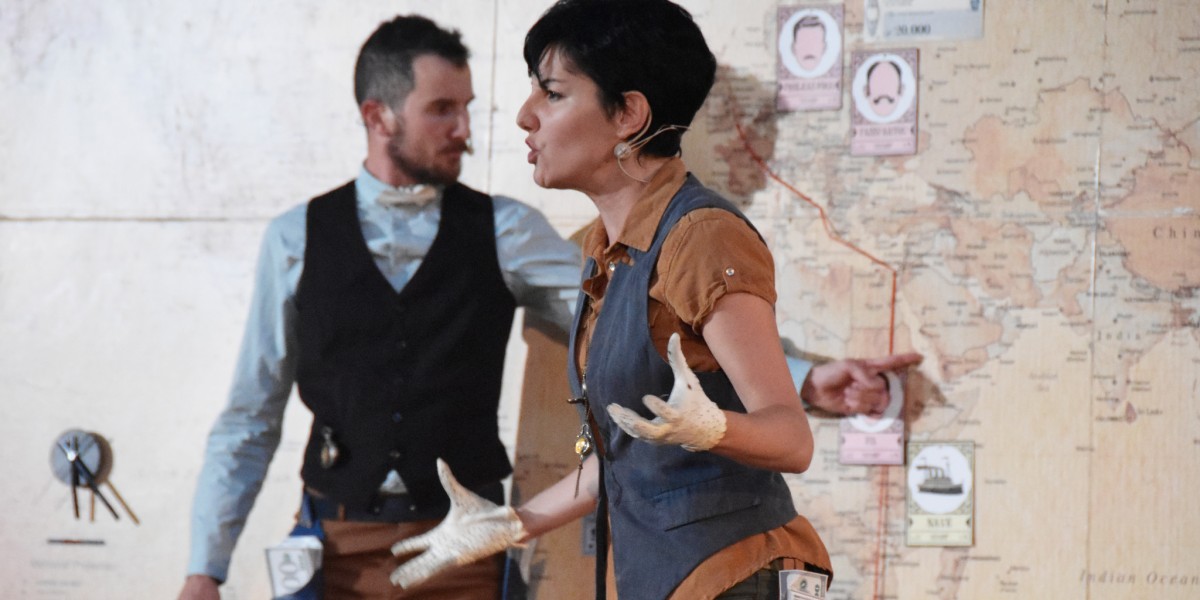
From London to Bombay
The audience sits waiting for the event to start, not quite sure if what expects them is a theatrical performance, a book reading, a meeting of the cultures of our planet, or an interactive game. Spoiler alert: it’s going to be all of them. We are in the Museum of the Fire Brigade - and this is an important detail to remember for later - on the wooden stage, surrounded by old firefighting equipment, sitting a giant map of the world and a metal box hiding the DJ console and, a few moments later, the lower half of Mattia Tuliozi’s body, the DJ himself, silently walking on stage.
As the background music starts and the two actors, Claudio Cirri and Sara Bonaventura, join the DJ, we are no longer in the Museum of the Fire Brigade, we are in the Reform Club in London, where the news about a recent robbery in the Bank of England is announced, letting the audience know that the slow rhythm of the past minutes is about to break. And it soon does.
The two actors, accompanied by music and sound effects, start bouncing from one role to the other, introducing the members of the club who talk about how easy it could be for the robbers to run around the world without getting caught. Mr. Fogg joins the conversation, stating that moving around the world in 1872 is so much faster than 100 years earlier, a complete lap around the globe can now be done in 80 days. The discussion quickly turned into a bet, Mr. Fogg – together with his butler, Passepartout - will attempt the trip: London to London in 80 days, the prize, £20,000, which is the modern day equivalent of €2 million, give or take.
At this point the format of the event changes, precise rules for the trip around the world are introduced as if it were all part of a game. The story will proceed through the drawing of cards containing facts, questions for the audience, descriptions of events that may or may not help the travellers, and other instructions for the game. The giant map will be the board will show the movements of the protagonists. The central part of the story, and the interactive game presented by the Sotterraneo Theater Company kicks off and the objective of this first event is to get to Bombay from London.
The first part of journey takes the audience to Suez, Egypt, on a plane – anachronistic, but the audience is told to go with it - and includes the startling revelation that the thief who robbed the Bank of England happens to look exactly like Mr Fogg. Detective Fix is suspicious of our protagonist and decides to follow him on his journey around the world. This section sees the introduction of the Tourist Guide, a game element that will reinterpret the encyclopaedic aspect of Verne’s book in a modern key, with a recorded voice talking about the locations that the protagonists find them in, in this case discussing the subject of emigration from Northern Africa to Europe.
In the second chapter, the Mongolia steamer gets us to Bombay, India some 48 hours earlier than Mr. Fogg had planned, 17 days after leaving London. A lucky card means that Detective Fix’s telegram containing an arrest warrant for Mr. Fogg didn’t get to Bombay in time. In chapter three, we travel across India by train to the soundtrack of What a Wonderful World by Louis Armstrong while the Tourist Guide discusses the impact of the touristic industry on elephants.
Chapter four takes us to a temple where a human sacrifice is about to be made, a young girl is to be burned together with her dead husband. Mr. Fogg and Passepartout decide to save her with the help of a former fire fighter and the manager of the Museum of the Fire Brigade with the use of an old motorcycle that was once used firefighters. The rescue was a success and Mr. Fogg rides away with the firefighter, waving a fire extinguisher in the air, bringing the first episode to an end. Tomorrow’s leg of the journey will take us from Bombay to Yokohama, bon voyage!



